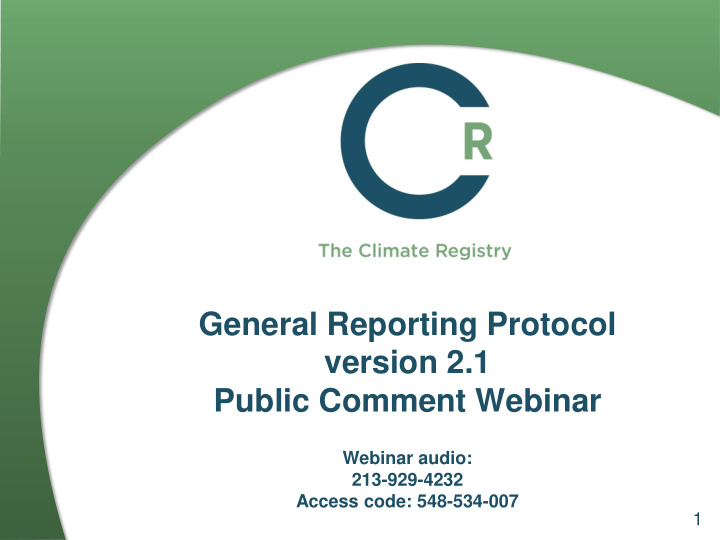



General Reporting Protocol version 2.1 Public Comment Webinar Webinar audio: 213-929-4232 Access code: 548-534-007 1
Logistics To ask questions: Type your question into the question box on your control panel Questions will be read aloud during Q&A at the end of the webinar A copy of the slides and a recording of the webinar will be distributed to all participants later this week 2
Introductions Peggy Kellen Michelle Zilinskas Jenna Jorns, PhD Coordinator, Verification Director of Policy Policy Associate The Climate Registry The Climate Registry The Climate Registry (213) 542-0291 (213) 542-0283 (213) 784-4165 pkellen@theclimateregistry.org mzilinskas@theclimateregistry.org jjorns@theclimateregistry.org 3
Agenda Overview of The Climate Registry GHG Protocol and the Scope 2 Guidance General Reporting Protocol version 2.1 Key updates Next steps Questions & comments 4
OVERVIEW OF THE CLIMATE REGISTRY 5
The Climate Registry We empower the world’s leading organizations with the highest quality carbon data in order to operate more efficiently, sustainably and competitively. Provide tools and member support Foster community of members & policy makers Recognize leadership Author general and sector specific guidance & protocols “You can only manage what you measure.” 6
Community of Members 7
TCR’s General Reporting Protocol Voluntary reporting requirements outlined in GRP Based on international best practice Current version: GRP v. 2.0: March 2013 Update process Annual updates as needed Updates and Clarifications: June 2014 8
GHG PROTOCOL AND THE SCOPE 2 GUIDANCE 9
GHG Protocol GHG Protocol partnership A Corporate Accounting and Reporting Standard First published 2001 Revised 2004 Provides standards and guidance to companies reporting GHG inventories International best practice 10
GHG Protocol Corporate Standard NF 3 Graphic courtesy of GHG Protocol (World Resources Institute/World Business Council on Sustainable Development) 11
GHG Protocol Scope 2 Guidance Why was it developed? Electricity is a significant source of emissions for companies 40% of global emissions The energy market has changed profoundly since 2001 More government requirements for sourcing renewable energy Growth of renewable energy markets Confusion around double counting of emissions amid inconsistent reporting requirements 12
GHG Protocol Scope 2 Guidance Published Jan 2015 Amendment to the Corporate Standard Policy neutral, standardized accounting methods Highlights include: New reporting requirements Disclosure recommendations 13
GENERAL REPORTING PROTOCOL VERSION 2.1 14
TCR’s GRP Update Process TCR drafted GRP v. 2.1 Consistent with new requirements in Scope 2 Guidance Incorporation of previous Updates and Clarification documents Addition of other minor policy updates Public Comment Period: Nov. 23 – Dec. 23 GRP v. 2.1 distributed: Nov. 23 Public webinar: Dec. 8 Please submit comments using the public comment template to policy@theclimareregistry.org by Dec. 23 15
KEY UPDATES 16
Key Updates Dual reporting of two Scope 2 totals Definition of complete reporting Eligibility criteria for contractual instruments Supplemental information to disclose TCR-recognized resources and technologies for clean energy 17
Dual Reporting New requirement to publicly report Scope 2 emissions in two ways: Location-based method: quantifies average emissions from electricity generated and consumed in a Member’s geographic region(s) of operations within a Member’s boundaries, primarily using grid-average emission factors Market-based method: quantifies emissions from electricity generation and consumed that a Member has purposefully purchased, using emission factors conveyed through contractual instruments between the Member and the electricity or product provider. Are these methods presented in a clear and logical way? If not, what would be more approachable? 18
Location-based method Location-based method emission factor hierarchy Location-A. Source-specific emission Direct line factors (if applicable) U.S. eGRID total output emission rates (Table 14.1) Location-B. Regional or sub-national emission factors Canadian emission factors for grid electricity by province (Table 14.2) Mexican emission factors for grid electricity (Table 14.3) Location-C. National production emission factors International Energy Agency national electricity emission factors (Table 14.4) 19
Market-based method Market-based method emission factor hierarchy Market-A. Electricity attribute Renewable Energy Certificates (RECs) (U.S., certificates (or equivalent Canada, Australia) instruments) Power Purchase Agreements (PPAs) Market-B. Contracts Contracts from specific sources (e.g., coal, nuclear) TCR EPS delivery metrics Market-C. Supplier/Utility-specific emission rates Green Power Products (GPP) Market-D. Residual mix (sub- Green-e residual mix for NERC regions national or national) Market-E. Other grid-average See location-based emission factor hierarchy emission factors 20
Definition of Complete Reporting Complete reporting to TCR includes emissions from operations in North America: Scope 1 emissions Scope 2 emissions • Location-based total • Market-based total Direct and indirect emissions from the combustion of biomass Are there any reasons why reporting natural gas in leased spaces should not be required for complete reporting? 21
TCR Eligibility Criteria Contractual instruments must : 1. Convey GHG information 2. Prevent double counting 3. Be retired 4. Be of recent vintage 5. Be sourced from same market as operations Utility-specific emission factors must: 6. Be calculated based on delivered electricity Direct line generation must: 7. Convey GHG claims to the Member All contractual instruments must be sourced from : 8. Markets with an adjusted residual mix, or its absence must be disclosed. 22
Supplemental Information Required: Lack of an adjusted residual mix if one is not available Scope 2 method used to calculate base year emissions, if applicable Recommended: Contractual instrument labels and features (facility features, policy context) Total annual electricity consumption (i.e., kWh, BTU) Contractual instruments that do not meet TCR Eligibility Criteria Advanced grid studies or real-time information 23
TCR-recognized Resources and Technologies List updated for clean energy Wind Solar Geothermal Nuclear Hydroelectric Biomass Are these broad definitions acceptable? If not, what additional specificity would be helpful? 24
NEXT STEPS 25
Next Steps Step Date GRP v. 2.1 distributed Nov. 23, 2015 Public webinar Dec. 8, 2015 Comment deadline Dec. 23, 2015 Adoption by TCR Board January 2016 Launch of 2016 reporting cycle February 2016 TCR Policy Contact Information Phone: (866) 523-0764 ext. 742 Email: policy@theclimateregistry.org 26
QUESTIONS AND COMMENTS 27
Thank You! A PDF copy of the slides and recording of the webinar will be sent later this week. 28
Recommend
More recommend